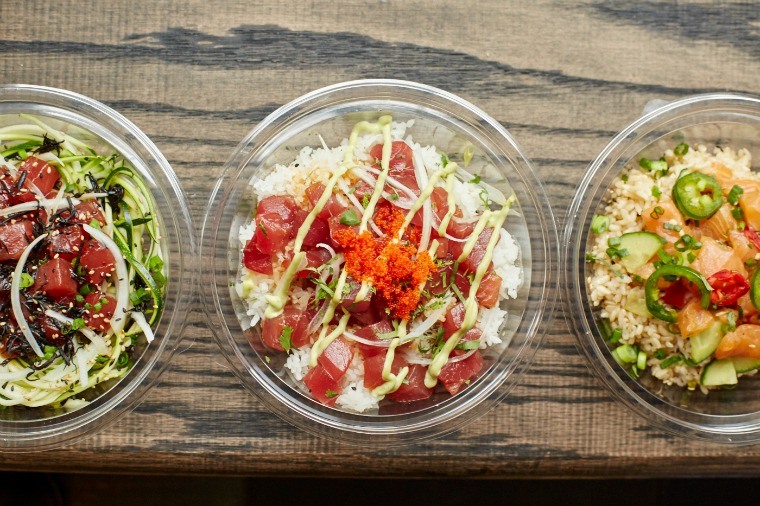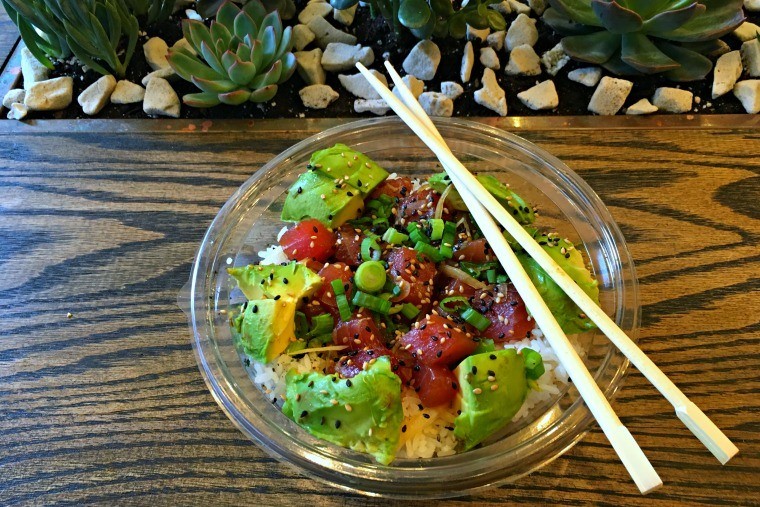Addicted to poké, the new bowl sensation that's the Hawaiian cousin of ceviche and sushi? You're not alone. But you don’t have to book a flight to the island or line up at one of the poké shacks popping up on the mainland to enjoy this fresh, raw fish salad. Yes, that's right: You can make it at home.
Before you squirm and click away at the scary thought of prepping raw fish in your kitchen (cue Salmonella nightmares), take a deep breath. It’s really not that hard, says Drew Crane, co-founder of New York City's Wisefish Poké. “Poké is a beautifully simple dish. Once you have great seafood in hand, it's relatively easy to make and enjoy—just one of the many reasons we fell in love with it,” says Crane.
The key is fresh fish. “You’re using really high-quality fish that’s meant to be eaten raw,” says Adam Geringer-Dunn, co-owner of Greenpoint Fish & Lobster Co. in Brooklyn. “If you have fresh fish, you don’t have to worry so much about getting sick.”
Ready to bring some aloha to your next meal? Crane and Geringer-Dunn offer these super simple tips—plus a recipe for making a drool-worthy poké bowl right at home.

1. Talk to your fishmonger
“You want someone who’s willing and able to have a conversation with you about what you’re looking to purchase and how you’re going to prepare it,” says Geringer-Dunn. “That’s about 80 percent, maybe 90 percent, of the battle.” Tell the fishmonger you want to make poké and ask for a recommendation based on what’s in stock. “They should know when the fish came in and how it came in,” he says. They’ll steer you toward the freshest fish with the right texture for being eaten raw.

{{post.sponsorText}}
“Don’t be afraid to ask where, when, and how the fish was caught,” says Crane. “Any great fishmonger or market would be happy to share that information.” And stick with domestic seafood since it’s a well-regulated industry, says Geringer-Dunn. “Pacific-caught tuna is generally better than Atlantic,” he says. “And if it’s caught in the US, it’s still better than if it’s imported.”
2. Use your senses
“You should look at [the fish] and say, ‘I’m excited to eat this. I want to eat this whole thing raw,’” says Geringer-Dunn. “Use your senses. You want to smell it and look at it.”
For Geringer-Dunn, he considers texture first. “Tuna and salmon are used primarily [for poké] because they have a buttery quality. When you bite into it, it melts in your mouth,” he says. They also have high fat content, which helps carry the strong flavors of sesame and soy in poké. Other good picks include Arctic char, mahi mahi, and snapper—but ask your fishmonger for what the best option is on hand that day.
Then, look for bright colors and a nice shine. Steer clear of the "fishy"-smelling fish. “That’s not what fish smells like; that’s what decomposing fish smells like,” says Geringer-Dunn. “It should smell clean, like the ocean.”
3. Keep it cool
Keep the raw fish in the fridge until you’re ready to use it. “Don’t let the fish sit out while you’re prepping everything else. Prep the other ingredients first,” says Geringer-Dunn. Plus, raw fish is easier to cut when it’s cold.
Pro tip: You want to make one clean cut in the fish, so the longer the blade, the better. In other words, don’t use a paring knife or you’ll destroy the texture of the fish. (Geringer-Dunn’s personal favorite is a Miyabi knife.)
4. Keep it clean
Don’t forget to wash your cutting board and knives in hot soapy water too. “As a rule of thumb, it’s good to keep things separated,” says Geringer-Dunn. That means keep the raw fish separate from your veggies, including a separate cutting board. “If the quality of the fish is high, there shouldn’t be any issue in the immediate sense of cross-contamination. It’s all going into the same bowl anyways,” he says.
5. Serve it fresh
And once your poké is prepped and properly marinated (more on that in a sec!), serve it immediately. “There’s some salt and acid in the marinade,” says Geringer-Dunn. “There’s a fine line between letting all the flavors come together and over-marinading and losing the texture of the fish.”

Don’t believe us that making poké at home is easy? Here’s a super simple recipe from Wisefish Poké. Once you get the hang of making the dish, experiment with other sauces and mix-ins!
Shoyu/Sesame Oil Ahi Poké
1 pound fresh ahi (sashimi-grade yellowfin or bigeye tuna)
3 Tbsp tamari shoyu
1 Tbsp sesame oil
1 tsp gluten-free oyster sauce
1/3 cup sweet onion, julienned
1/2 tsp freshly-grated ginger
1/4 cup scallion, chopped
1 whole avocado, cubed
Toasted sesame seeds, to taste
Pat the ahi fillet dry. Cut neatly into 1/2-inch cubes, and transfer to a large mixing bowl. Place in refrigerator. In a smaller bowl, whisk together the shoyu, sesame oil, oyster sauce, and fresh-grated ginger. Remove mixing bowl from fridge, and add the sweet onions.
Pour the shoyu/sesame mixture into the large bowl, gently folding the ahi and sweet onions together, allowing the sauce to lightly coat the poké. Allow ingredients to marinate in the refrigerator for 30 minutes to an hour.
To finish, top with avocado, scallions, and a sprinkling of toasted sesame seeds. Serve over warm rice (white or brown), zucchini noodles, or crunchy corn tortilla chips. Enjoy!
And for dessert? A frozen treat is a perfect complement to super-chill poké: Try this mint chocolate chip "nice cream" recipe, or these recipes using the coolest healthy fruit around.
Loading More Posts...